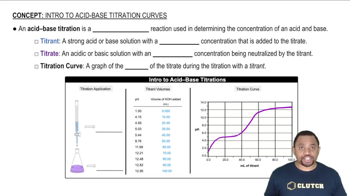The following plot shows two pH titration curves, each representing the titration of 50.0 mL of 0.100 M acid with 0.100 M NaOH:
. (a) Which of the two curves represents the titration of a strong acid? Which represents a weak acid?





The following plot shows two pH titration curves, each representing the titration of 50.0 mL of 0.100 M acid with 0.100 M NaOH:
. (a) Which of the two curves represents the titration of a strong acid? Which represents a weak acid?
The following plot shows two pH titration curves, each representing the titration of 50.0 mL of 0.100 M acid with 0.100 M NaOH:
. (b) What is the approximate pH at the equivalence point for each of the acids?
The following plot shows two pH titration curves, each representing the titration of 50.0 mL of 0.100 M acid with 0.100 M NaOH:
. (c) What is the approximate pKa of the weak acid?
The following pictures represent solutions at various stages in the titration of a weak base B with aqueous HCl. (Cl- ions and solvent water molecules have been omitted for clarity.)
. (b) Is the pH at the equivalence point more or less than 7?
The following pictures represent solutions at various stages in the titration of sulfuric acid H2A (A2- = SO4 2-) with aqueous NaOH. (Na+ ions and water molecules have been omitted for clarity.)
. (a) To which of the following stages do solutions 1–4 correspond? (i) Halfway to the first equivalence point (ii) Halfway between the first and second equivalence points (iii) At the second equivalence point (iv) Beyond the second equivalence point